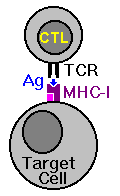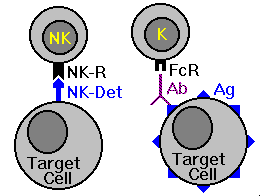The second arm of the immune response is refered to as Cell Mediated Immunity (CMIR). As the name implies, the functional "effectors" of this response are various immune cells. These functions include:
- Phagocytosis and killing of intracellular pathogens
- Direct cell killing by cytotoxic T cells
- Direct cell killing by NK and K cells
These responses are especially important for destroying intracellular bacteria, eliminating viral infections and destroying tumor cells. This page will discuss the cell-mediated immune response, focusing on the mechanisms involved.
MACROPHAGE ACTIVATION
While the production of antibody through the humoral immune response can effectively lead to the elimination of a variety of pathogens, bacteria that have evolved to invade and multiply within phagocytic cells of the immune response pose a different threat. The following graphics illustrate this dilemma:
| Extracellular microorganisms |
 |
 |
|
 |
|
 |
|
 |
|
 |
 |
 |
 |
|
Non-encapsulated microorganisms are easily phagocytosed and killed within macrophages. |
 |
 |
 |
 |
 |
 |
 |
 |
 |
 |
 |
 |
 |
|
Encapsulated microorganisms require the production of antibody in order to be effectively phagocytosed. Once engulfed, however, they are easily killed. |
| Intracellular microorganisms |
 |
 |
 |
 |
 |
 |
 |
 |
 |
 |
 |
 |
 |
|
Intracellular microorganisms elicit the production of antibody, which allows effective phagocytosis. Once engulfed, however, they survive within the phagocyte and eventually kill it. |
 |
 |
 |
 |
 |
 |
 |
IFN
TNF |
 |
 |
 |
 |
|
Intracellular microorganisms also activate specific T-cells, which then release lymphokines (e.g. IFN, TNF) that cause macrophage activation. Activated ("killer") macrophages are then very effective at destroying the intracellular pathogens. |
This process can be further illustrated by considering the following experiment known as "Koch's phenomenon":
- Inoculation of an unimmunized guinea pig with a lethal dose of the intracellular pathogen Mycobacterium tuberculosis (MT) results in death of the animal. Inoculation with a sub-lethal dose induces immunity.
- Inoculation of an MT-immunized guinea pig with a lethal dose of MT causes a local reaction ("delayed hypersensitivity") one to two days later.
- Inoculation of an MT-immunized guinea pig with a lethal dose of a different intracellular pathogen, Listeria monocytogenes (LM) again results in death of the animal.
- Inoculation of an MT-immunized guinea pig with a lethal dose of LM and MT causes a delayed hypersensitivity reaction.
These results demonstrate the specific (T-cell mediated) and non-specific (macrophage mediated) aspects of this type of cell mediated immunity.
CELL MEDIATED CYTOTOXICITY
The second half of the cell-mediated immune response is involved in rejection of foreign grafts and the elimination of tumors and virus-infected cells. The effector cells involved in these processes are cytotoxic T-lymphocytes (CTLs), NK-cells and K-cells. Each of these effector cells recognizes their target by different means, described below.
Cytotoxic T-lymphocytes
 CTLs, like other T-cells are both antigen and MHC-restricted. That is, CTLs require i) recognition of a specific antigenic determinant and ii) recognition of "self" MHC (Click here to review these requirements). Briefly, CTLs recognize antigen via their T-cell receptor. This receptor makes specific contacts with the antigenic determinant and the target cell's class I MHC molecule. CTLs also express CD8, which may assist the antigen recognition process. Once recognition is successful, the CTL "programs" the target cell for self-destruction. This process is thought to occur in one of several possible ways. First, CTLs may release a substance known as perforin in the space between the CTL and its target. In the presence of calcium ions, the perforin polymerizes, forming channels in the target cell's membrane. These channels may cause the target cell to lyse. Second, the CTL may also release various enzymes that pass through the polyperforin channels, causing target cell damage. Third, the CTL may release lymphokines and/or cytokines that interact with specific receptors on the target cell surface, causing internal responses that lead to destruction of the target cell. CTLs principally act to eliminate endogenous antigens. Click here for more information.
CTLs, like other T-cells are both antigen and MHC-restricted. That is, CTLs require i) recognition of a specific antigenic determinant and ii) recognition of "self" MHC (Click here to review these requirements). Briefly, CTLs recognize antigen via their T-cell receptor. This receptor makes specific contacts with the antigenic determinant and the target cell's class I MHC molecule. CTLs also express CD8, which may assist the antigen recognition process. Once recognition is successful, the CTL "programs" the target cell for self-destruction. This process is thought to occur in one of several possible ways. First, CTLs may release a substance known as perforin in the space between the CTL and its target. In the presence of calcium ions, the perforin polymerizes, forming channels in the target cell's membrane. These channels may cause the target cell to lyse. Second, the CTL may also release various enzymes that pass through the polyperforin channels, causing target cell damage. Third, the CTL may release lymphokines and/or cytokines that interact with specific receptors on the target cell surface, causing internal responses that lead to destruction of the target cell. CTLs principally act to eliminate endogenous antigens. Click here for more information.
NK cells
NK cells are part of a group know as the "large granular lymphocytes". These cells are generally non-specific, MHC-unrestricted cells involved primarily in the elimination of neoplastic or tumor cells.

The precise mechanism by which they recognize their target cells is not clear. Probably, there is some type of NK-determinant expressed by the target cells that is recognized by an NK-receptor on the NK cell surface. Once the target cell is recognized, killing occurs in a manner similar to that produced by the CTL.
K cells
K-cells are probably not a separate cell type but rather a separate function of the NK group. K-cells contain immunoglobulin Fc receptors on their surface and are involved in a process known as Antibody-dependent Cell-mediated Cytotoxicity (ADCC). ADCC occurs as a consequence of antibody being bound to a target cell surface via specific antigenic determinants expressed by the target cell. Once bound, the Fc portion of the immunoglobulin can be recognized by the K-cell. Killing then ensues by a mechanism similar to that employed by CTLs. This type of CMIR can also result in
Type II hypersensitivities.